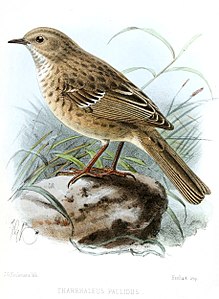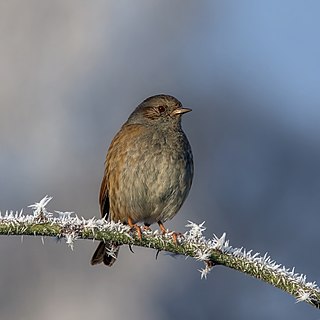
The accentors are a genus of birds in the family Prunellidae, which is endemic to the Old World. This small group of closely related passerines are all in the genus Prunella. All but the dunnock and the Japanese accentor are inhabitants of the mountainous regions of Europe and Asia; these two also occur in lowland areas, as does the Siberian accentor in the far north of Siberia. These birds are not strongly migratory, but they will leave the coldest parts of their range in winter and make altitudinal movements.
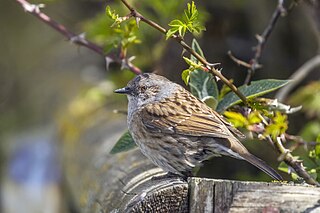
The dunnock is a small passerine, or perching bird, found throughout temperate Europe and into Asian Russia. Dunnocks have also been successfully introduced into New Zealand. It is by far the most widespread member of the accentor family; most other accentors are limited to mountain habitats. Other common names of the dunnock include: hedge accentor, hedge sparrow or hedge warbler.
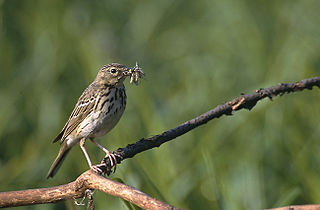
The tree pipit is a small passerine bird which breeds across most of Europe and the Palearctic as far East as the East Siberian Mountains. It is a long-distance migrant moving in winter to Africa and southern Asia. The scientific name is from Latin: anthus is the name for a small bird of grasslands, and the specific trivialis means "common".

The alpine accentor is a small passerine bird in the family Prunellidae, which is native to Eurasia and North Africa.
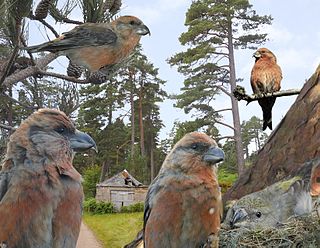
The Scottish crossbill is a small passerine bird in the finch family Fringillidae. It is endemic to the Caledonian Forests of Scotland, and is the only terrestrial vertebrate species endemic to the United Kingdom. The Scottish crossbill was confirmed as a unique species in August 2006, on the basis of having a distinctive bird song.
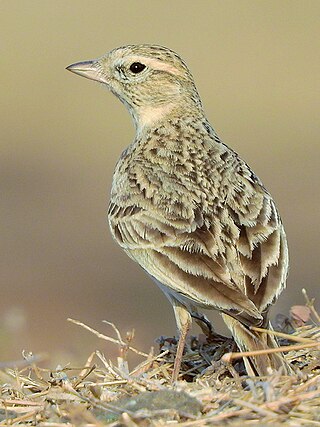
The greater short-toed lark is a small passerine bird. The current scientific name is from Ancient Greek. The genus name, Calandrella, is a diminutive of kalandros, the calandra lark, and brachydactila is from brakhus, "short", and daktulos, "toe".

The black-throated accentor is a small passerine bird found in the Ural, Tian Shan and Altai Mountains. It is migratory, wintering in Afghanistan and neighboring countries. It is a rare vagrant in western Europe.

The Siberian accentor is a small passerine bird that breeds in northern Russia from the Ural Mountains eastwards across Siberia. It is migratory, wintering in Korea and eastern China, with rare occurrences in western Europe and northwestern North America. Its typical breeding habitat is subarctic deciduous forests and open coniferous woodland, often close to water, although it also occurs in mountains and spruce taiga. It inhabits bushes and shrubs in winter, frequently near streams, but may also be found in dry grassland and woods.
The Tibetan babax is a species of bird in the family Leiothrichidae. It is endemic to China. It is threatened by habitat loss.
The Tibetan bunting is a species of bird in the family Emberizidae. It is endemic to eastern side of the Tibetan Plateau.
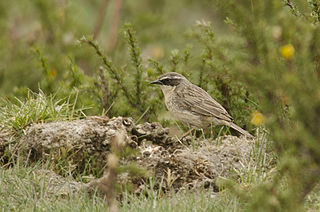
The brown accentor is a species of bird in the family Prunellidae. It is found in Afghanistan, China, India, Kazakhstan, Mongolia, Nepal, Pakistan, Russia, Tajikistan, Turkmenistan, and Uzbekistan.
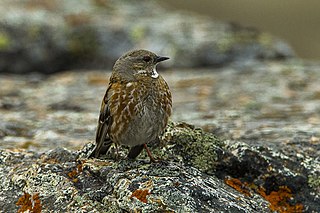
The Altai accentor is a species of bird in the family Prunellidae. It is also known as the rufous-streaked accentor or Himalayan accentor. It breeds in the Altai Mountains of western Mongolia; it winters in the southern Tian Shan and Himalayan ranges.

The maroon-backed accentor is a species of bird in the family Prunellidae. It is found in Bhutan, China, India, Myanmar, and Nepal.

Radde's accentor is a species of bird in the family Prunellidae. It is found in mountainous parts of Yemen and northern Southwest Asia.

The robin accentor is a species of bird in the family Prunellidae. It is found in the mountainous regions of Afghanistan, Pakistan, India, Nepal, Bhutan and China, at altitudes between about 3,000 and 5,500 m. It is a brown bird with a grey head and an orange-red breast. It is common in parts of its range and its conservation status has been assessed by the International Union for Conservation of Nature as being of "least concern".
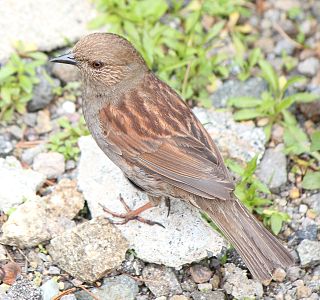
The Japanese accentor is a species of bird in the family Prunellidae. It is found in Japan and Sakhalin.

The rufous-breasted accentor is passerine bird in the family Prunellidae, endemic to the Himalayas, descending in the winter to lower-to-middle altitudes. It is found in Afghanistan, Bhutan, Tibet, China, India, Myanmar, Nepal, and Pakistan.

The hairy-crested antbird is a species of bird in the family Thamnophilidae. It is found in Bolivia, Brazil, Colombia, Ecuador, and Peru. Its natural habitat is subtropical or tropical moist lowland forests.

The Mongolian short-toed lark or Sykes's short-toed lark is a species of lark in the family Alaudidae. It breeds in China and Mongolia and winters in southern Asia.
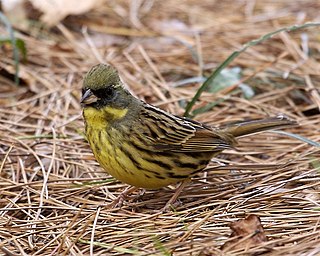
The masked bunting is a passerine bird in the bunting family Emberizidae. It is found in Sakhalin, the Kuril Islands, and Japan.
